Tillandsia lotteae
Click thumbnails for full size, scaled to a new window.
Tillandsia lotteae
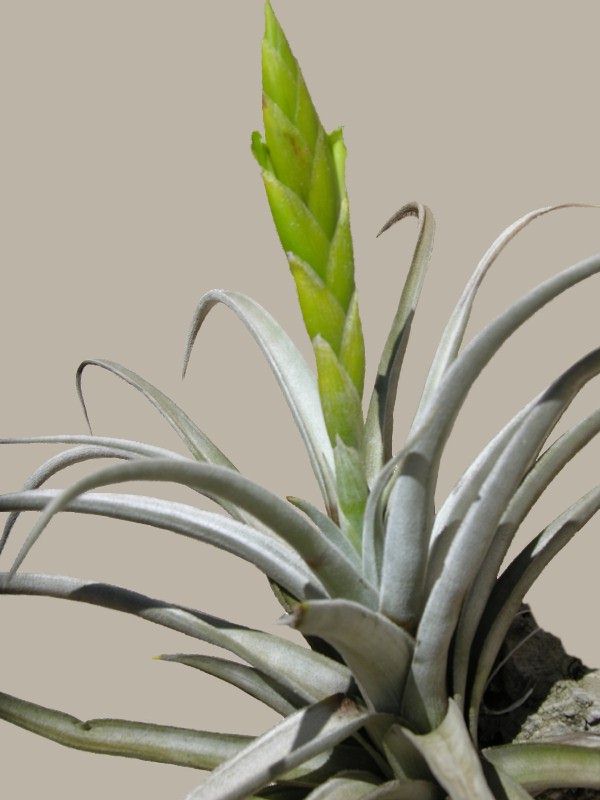
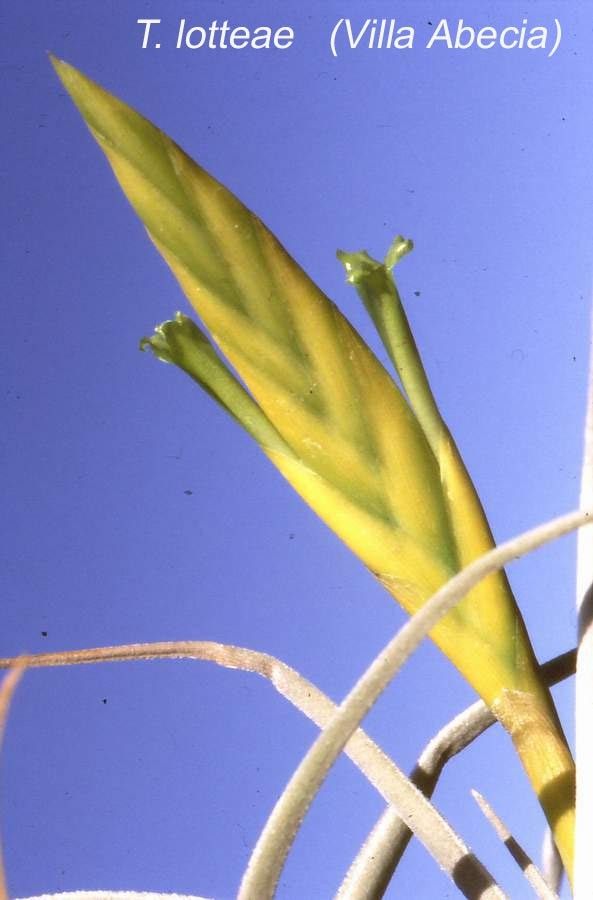

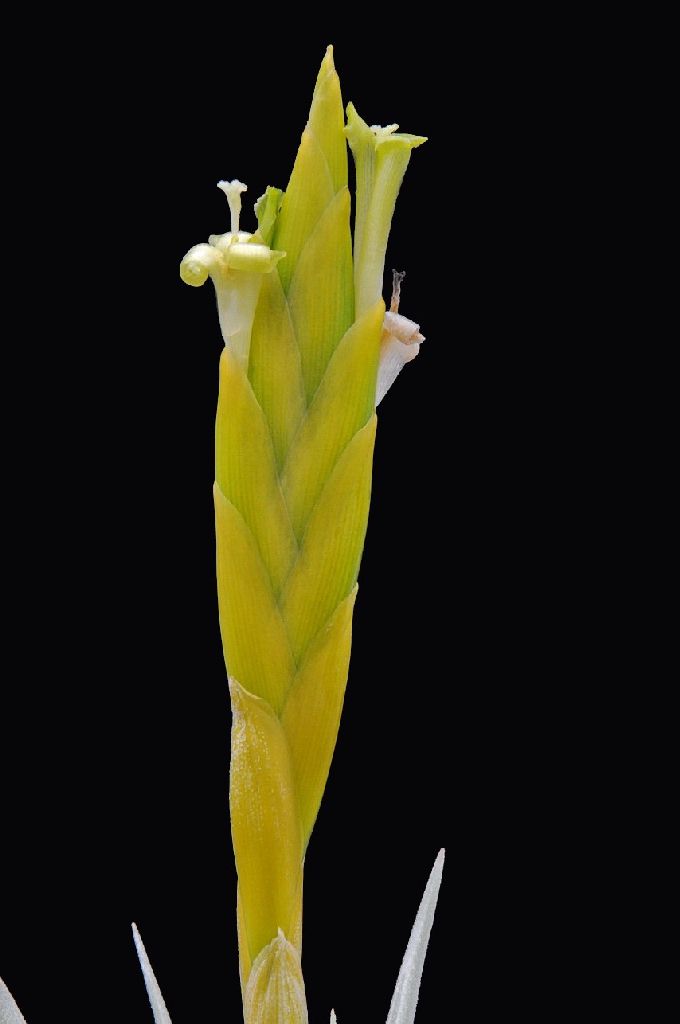
| Len Colgan 04/13. |
Len Colgan - two forms from Bolivia, 1995. |
Peter Tristram 04/13. |
Len Colgan ... "originally collected in 1993 just north of Villa Abecia in Bolivia.
For those who have obtained this general species from me, this form is BOL #26.
It was the most southerly habitat where I found T. lotteae, and was by far the largest form. Some of the plants at the location were more than 50cm high, but I restricted myself to two plants about 35cm high.
The first attached image is very old and of low resolution, but was taken around 1995 at my first flowering.
The second image would be third generation since then, now in flower. This plant is somewhat smaller (30cm high) than its great-grandparent and has disappointingly smaller flowers.
I have different forms of T. lotteae, from different locations, growing together. Over the years, seed has germinated on the shadecloth immediately behind these plants, which I have grown on, despite knowing that they are a very, very slow species, especially when I do not fertilise them at all. The largest seedlings are now 10cm across and 18 years old. There are lots of smaller ones, of course."
Peter Tristram... "I well remember the thrill of first seeing this species pictured in the BSI journal when it was described but it was a while before I finally obtained some.
Tropiflora! A story of dubious credentials accompanied those plants. (A story that can not be repeated here), I finally brought some home only to be gassed, with most dying. Despite its tough-looking appearance I have found it quite sensitive to MeBr and have lost many from my German imports too. I have never flowered either of the 2 remaining Tropiflora specimens. Len has had the privilege of seeing these magnificent Tillandsias in habitat, something most of us can only dream of. I have a few of Len's seedlings too, now about 3cm or so."
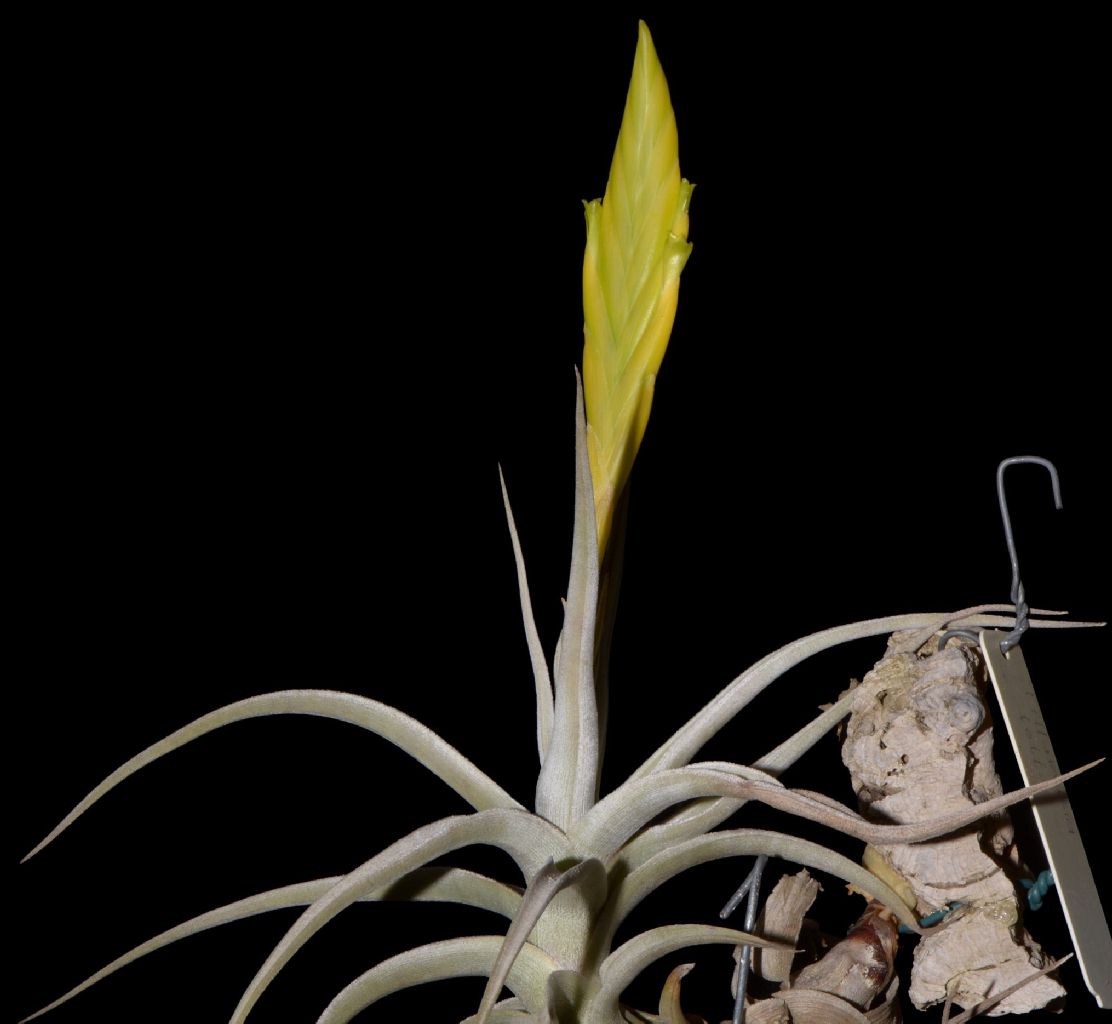

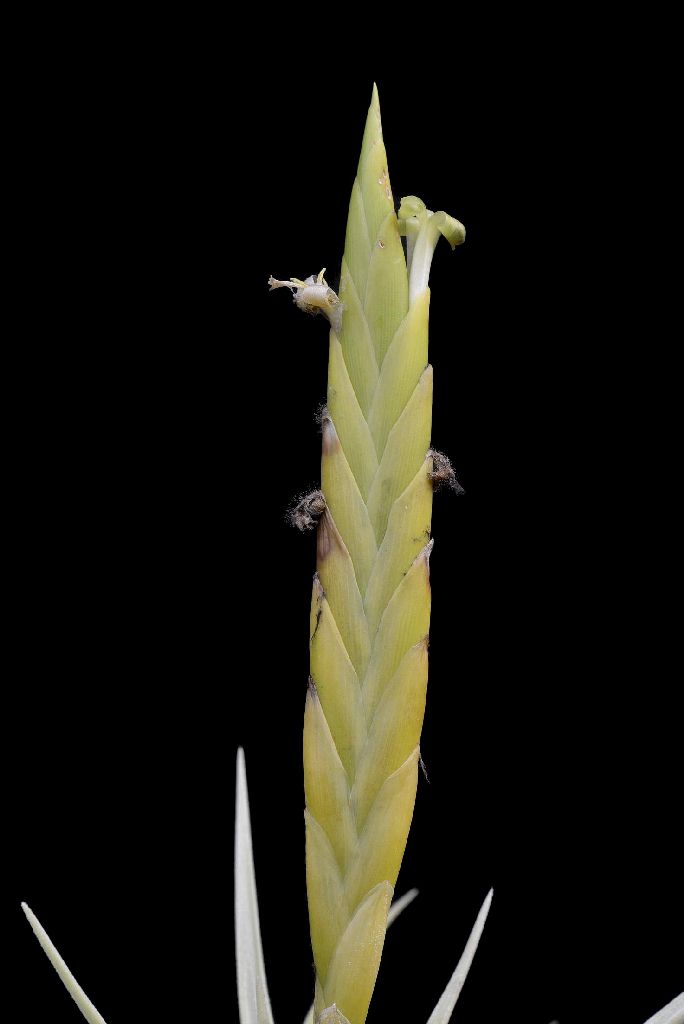

| George Nieuwenhoven 03/13. |
Peter Tristram 06/15. |
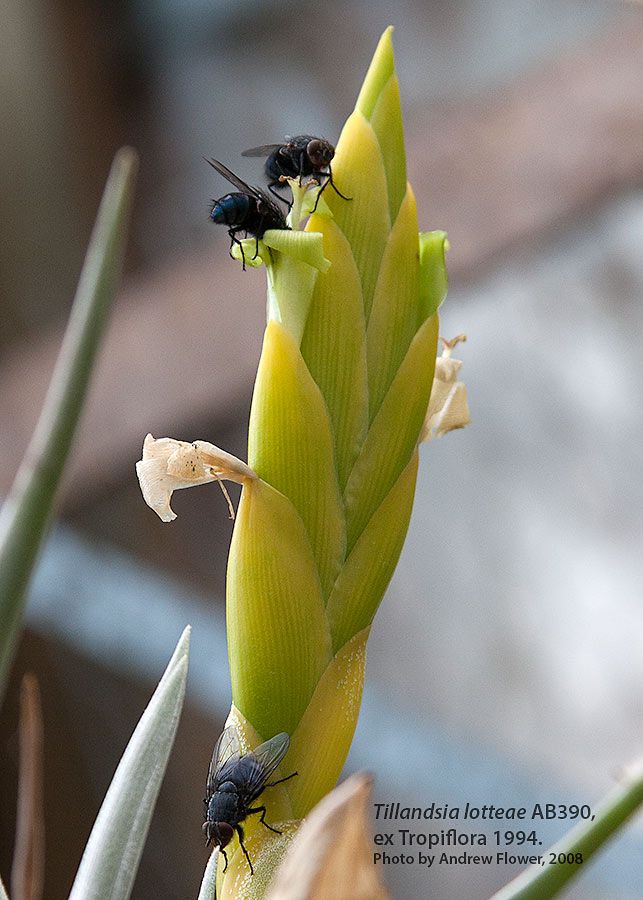
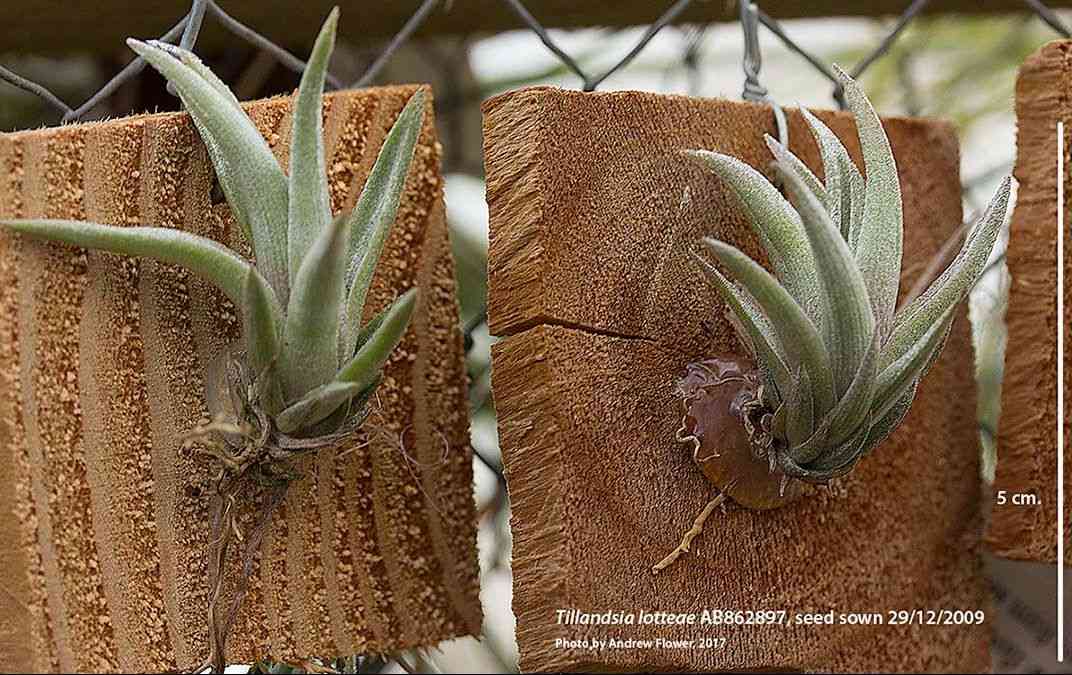

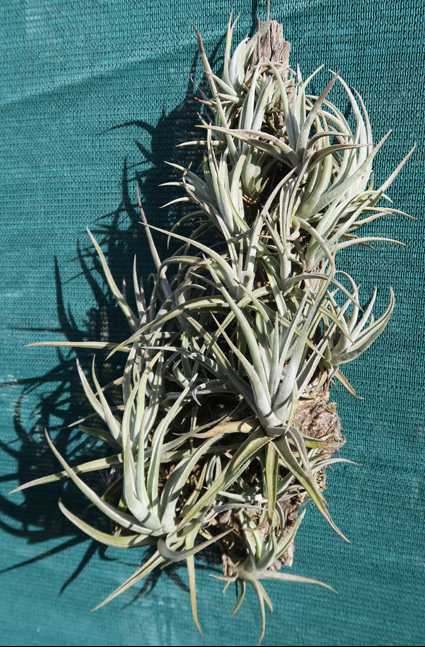
| Andrew Flower 06/17 |
Len Colgan 06/17. Lotte in habitat & 1995 seedlings |
Peter Tristram ... "I got some lotteae from Dennis in 1996 when I went to the World Conf in Orlando and bloomed the first one in 2015! Slow! Have you bloomed any yet?"
Andrew Flower ... "I got two different clones in the early/mid 1990's, and at least one (1994) came from Dennis. Bit of a saga with these!
Idea is always to get at least two different clones of a species to increase chance of obtaining seed. These two little devils flowered quite regularly from 1996/7 onwards, but never both in the same year. They took it in turns to flower.... incidentally they are a big favourite with the local flies (see pic).
In 2008 they finally flowered together, and I got seed on both -though you will see from the pic, they are not the fastest-growing tillandsias on the block. Still, up to 4cm in 8 years - mustn't grumble."
Len Colgan ... "I brought back four slightly different forms of T. lotteae from Bolivia in 1993. I mounted them on separate pieces of cork, but hung them together. In 1995, a few flowered and set seed themselves, becoming intermixed. Consequently, being unable to separate collecting numbers, they were set down together. Almost all germinated, and I have given away many of the seedlings over the years.
Anyway, 22 years on, the largest are 16.5cm in size. Still a long way to go! Lotte did tell me that her own seedlings were equally slow, even though I never fertilise.
I have attached an early image of Lotte in habitat, and a couple of old images from 1995 showing two different forms. Hopefully, someone is interested.
Also I have attached a picture of a number of the 1995 T. lotteae seedlings on a large piece of cork. The two biggest ones (16.5cm) are most likely the large form of T. lotteae from Villa Abecia (shown in the earlier email). In fact, one of the plants from Villa Abecia, collected by Helmut Alber, was so huge that I did not initially recognise it as this species. Sadly, Helmut kept it for himself, even though he is really a cactus collector. I know he sold it in Germany.
As the image indicates, there is quite a variation in the sizes after 22 years. But that is not surprising, especially knowing it is possible the seed came from different forms."
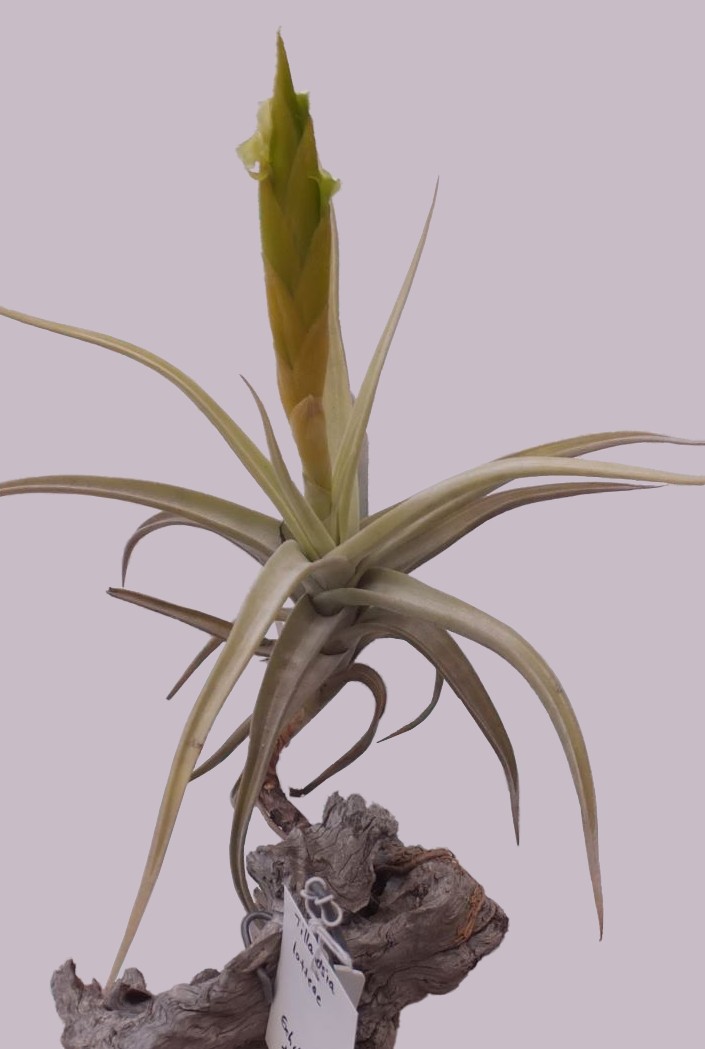
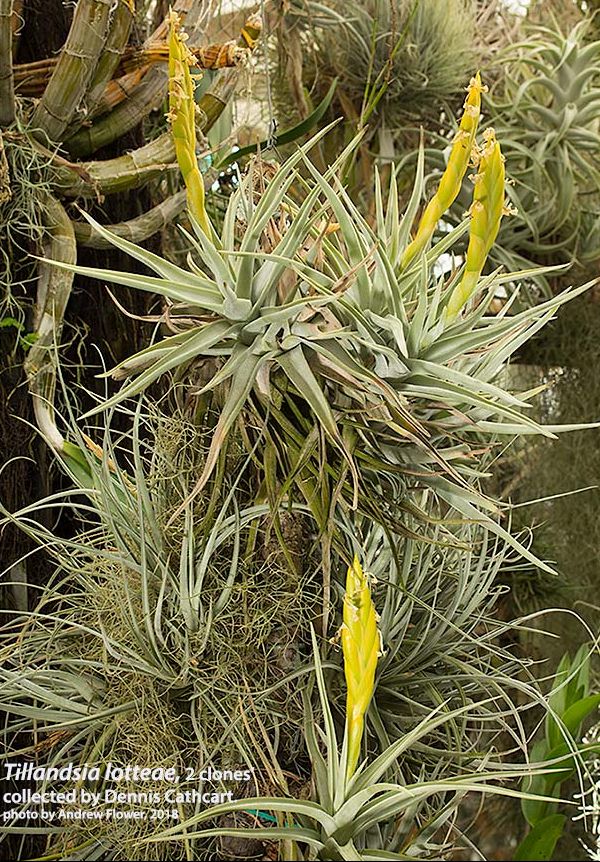


| Adam Bodzioch 03/18 |
Len Colgan 03/18 |
Justin Lee 12/20 |
Geoff Beech 04/21 |
Adam Bodzioch ... "Takes a while but always a nice till in bloom."
Len Colgan ... "Because this species is virtually non-existent at the type location, due to over-collecting, some people claim it is in danger. However, I know of at least twelve different locations where it can be found, some on private property into which I was granted access. Lotte did not know of them all, but of course she has been to other places I have not visited.
It is very slow growing, as Peter Tristram said. From all of the naturally produced seed (I didn't interfere) that I set down in 1995, 23 years ago, the largest plant is now only 11cm in size, while there are still several only 3cm in size. The second group, from about 2000, are much more numerous, with the largest being 7cm in size. They all grow well in Adelaide. I do not fertilise."
Andrew Flower ... "Pic of my two Tillandsia lotteae populations, finished flowering about a week ago - they came originally from Dennis Cathcart's early 1990's trip to Bolivia. I only ever got seed from them when they both flowered the same year, that was in 1989, and this year is only the second time this happened in 20 years.... normally one or other of them flowers nearly every year!
Len - I agree they are not the fastest cats on the block: my seedlings sown in 1990 are now between 5 and 6cm high and pretty solidly built. Must admit they receive a "tonic" 2-3 CF with each watering, which is pretty much daily in the growing season, and weekly in the off-season - in the growing-on house with min. night 11c and minimum day rise to 18C. on a multi-stage thermostat."
Justin Lee ... "First flowering for me. Has been in spike since January and finally sent out a flower. This clone seems to be a bit larger than most others I've seen."
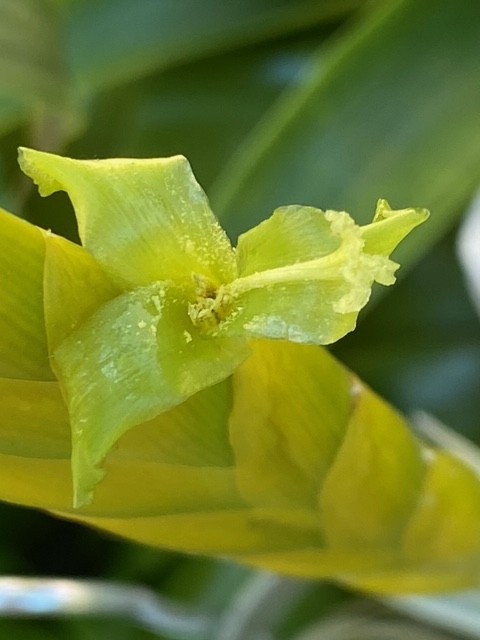
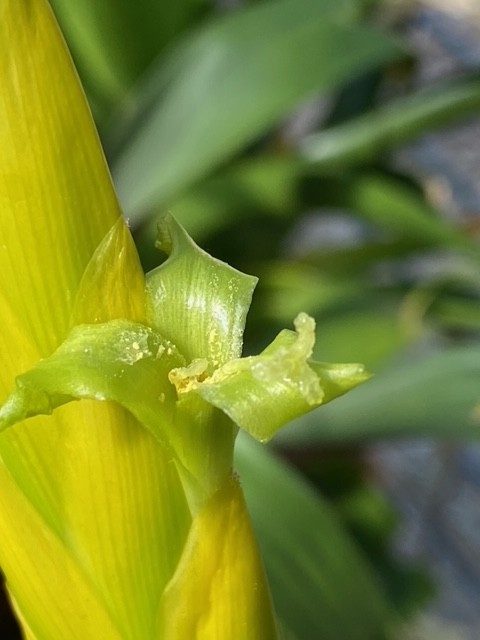

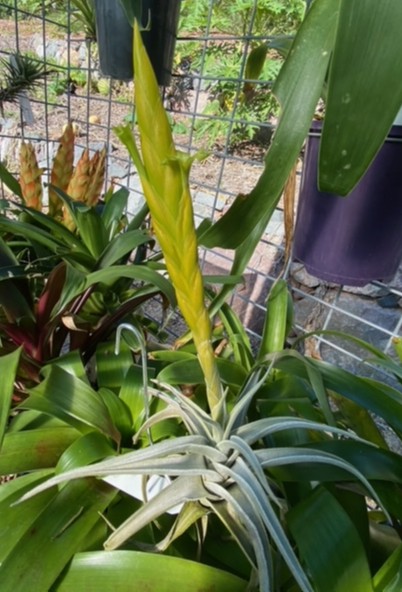
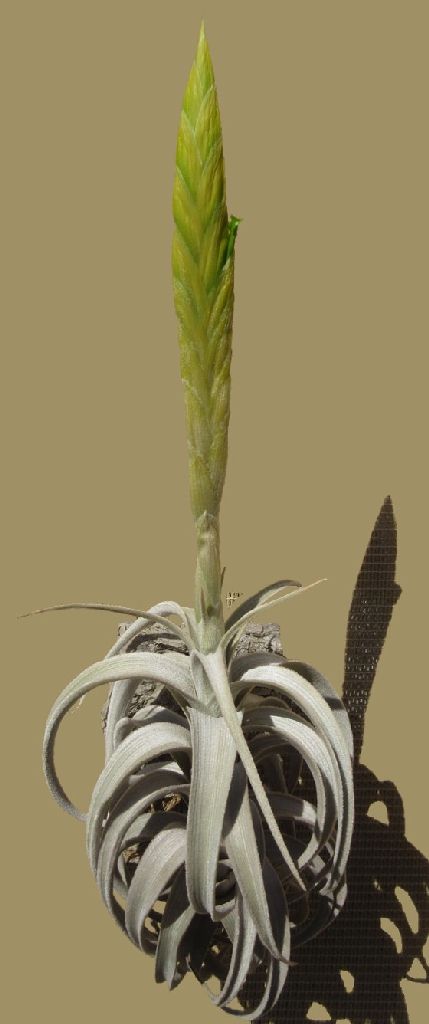
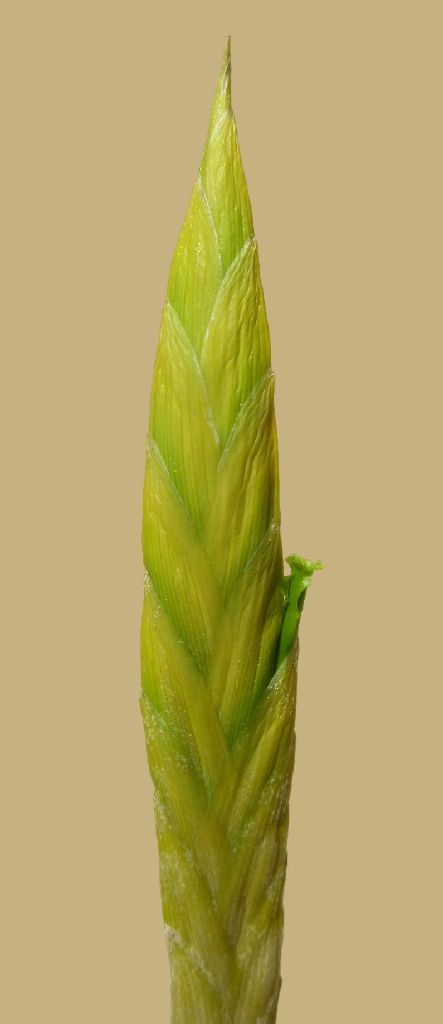
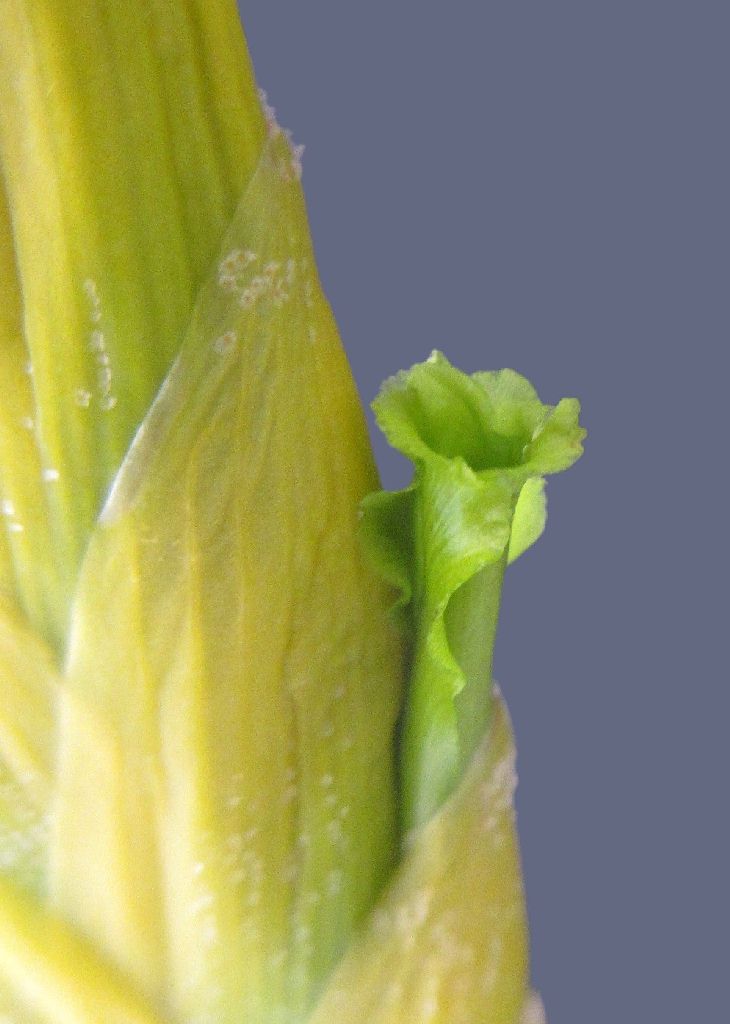
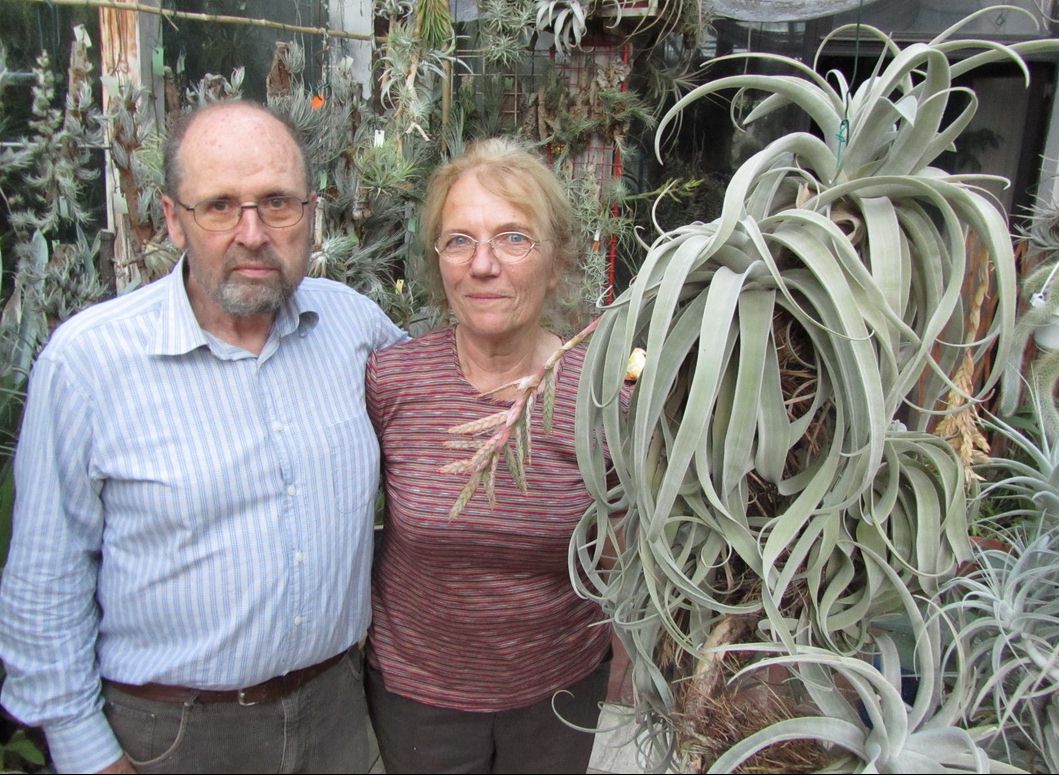
| Linda & Rohan Wilkes 03/19 ex. Adam Bodzioch 2015 |
Helmut & Lotte Hronradnik. Photo Justin Lee? |

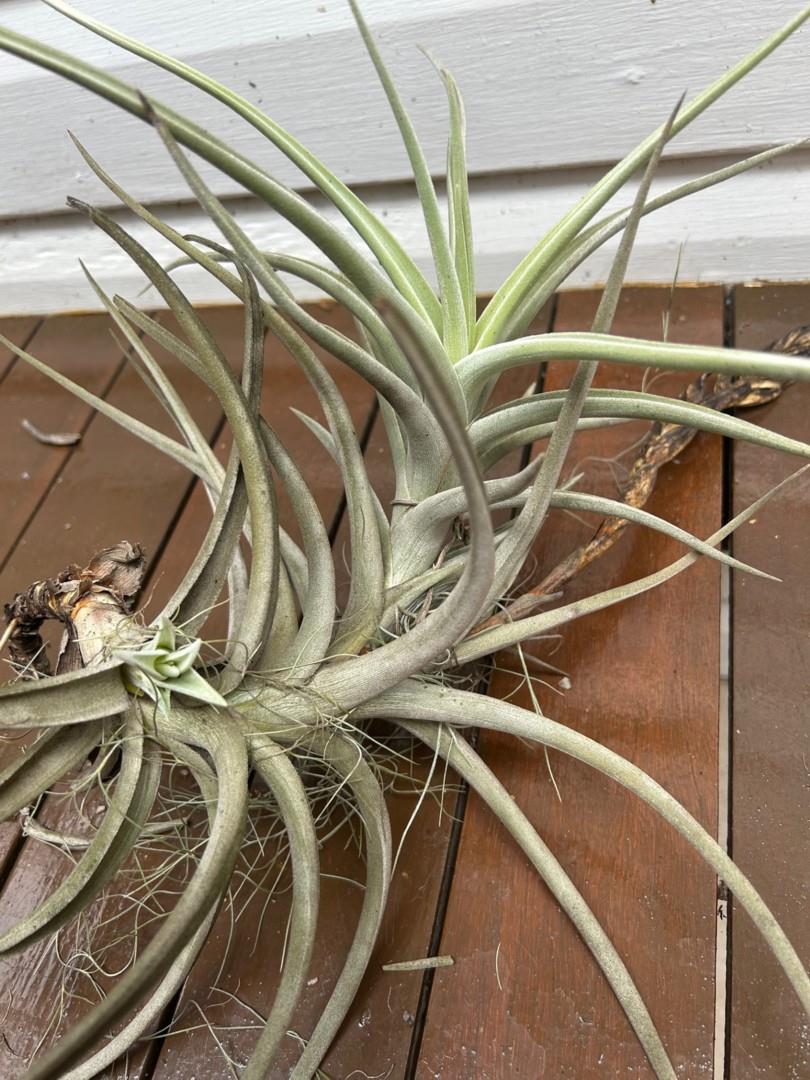
| Peter Tristram 03/23 |
Robert Reilly 12/24 |
Peter Tristram ... "One species that didn't like Repton but is thriving, in full sun at Tallai, is T. lotteae. The temperature hit 34 a few days ago, up to 37 previously, with no adverse affects like bract burn, unlike some others. One of these is from Lotte, the other from Tropiflora. I have been crosspollinating them."
Robert Reilly ... "Tillandsia lotteae usually only produces one pup for me, which is located near the inflorescence-it is an 'upper pupper'.
To remove this pup requires a certain amount of courage as the attempt may prove unsuccessful, and you may not get another pup.
However, 2 plants have recently produced another pup on their stem - see photo of one of them.
Have other nutters noticed this phenomenon?
(In my case, the pup seems to have been initiated after the plant has been lying on its side for a while, as opposed to being vertically suspended. Maybe a loss of 'apical dominance'--to use a forestry term, has allowed initiation of the 'bonus' pup?)
Edit: They are also on a 'high fertiliser' diet, compared with previous years. This may also have influenced the pupping behaviour."
Justin Lee ... "Never seen this pupping behaviour before. Interesting form too, mine has shorter leaves."
Robert Reilly ... "Thanks Justin. I imported 2 forms from Germany many years ago, but they look much the same to me.
In the past, I have always hung them vertically, but this time they were growing more horizontally--so I wonder if that changed the chemical balance in the stem which had previously inhibited pup development in the lower stem.
They are also on a high fertiliser diet which may also be relevant."
Ray Clark ... "Robert Reilly. I posted one recently that had a flower on each of the two pups. Both pups grew from the base of the original. I fertilised weekly/weakly and have done for a long time. My (clone) has shorter leaves than yours too."
Robert Reilly ... "Ray Clark Thanks, Ray Looks like fertiliser may be the answer!"
Tillandsia lotteae H Hromradnik - J. Brom. Soc 28(6):263 –5. 1978
Planta caulescens, florens usque ad 40 cm alta. Fo1ia numerosa, dense inserta, polysticha, reclinata. Vagina indistincta, 2,5-3 cm longa, 2,5-3 cm lata, denso cano lepidota. Lamina usque ad 15 cm longa, supra vaginam 15 mm lata, involuta, reclinata, denso argenteo - cano lepidota, angustae triangulata, apice subulato. Scapus Inflorescentiae 6 cm longus, erectus, teres, 5 mm diametiens, viridis, glaber. Folia scapi imbricata, multo longiora quam internodia, acuminata, mox dissicata, nervata, glaber. Inflorescentia simplex, ensiformis, complanata, plus minusve 10 cm longa, 2,5 cm lata, 10-14 flora. Bracteae florales distichae, dense imbricatae, 3-3,5 cm longae, explanatae 2 cm latae, ecarinatae, acuminatae, marginae membranaceo - limbatae, sepala superantes, primo luteae, nitidae, sub anthesi dissicatae, tum distinctae nervatae. Sepala usque ad 3 cm longa, 8 mm lata, acuminata, posteriora 2 mm connata, carinata, pallida viridia, glabra, leviter nervata. Petala linguiformia, 45-60 mm longa, 4 mm lata, apice serrata, recurvata, basi alba, in triente superiore luteola - viridia. Stamina usque ad 40 mm longa, antherae 7 mm longae, in parte superiore floris inclusae. Stylus inclusus.
Habitat: Sucre - Cochabamba (Dept. Chuquisaca, Bolivia), km 70, in rupibus abruptis, epiphytica, in valle fluminis Rio Chico, 1700 m.
Holotypus: H. Hromadnik 2 PB 77 (20.7. 77) Nr. 46776 in Herbario inst.bot.system. heidelbergensis (HElD).
PLANT caulescent, flowering up to 40 cm high; leaves numerous, polystichous, strongly recurved, up to 18 cm long.
SHEATHS scarcely distinct, 2,5-3 cm wide, pale densely white lepidote:
BLADES narrow-triangular attenuate, involute, up to 15 cm long, 15 mm wide, densely white lepidote;
SCAPE erect, up to 6 cm long, green, glabrous, longer than the blades.
SCAPE BRACTS imbricate, the lower ones subfoliaceous, the upper ones lanceolate, lepidote, soon drying.
INFLORESCENCE simple, lanceolate, complanate, up to 10 cm long and 2,5 cm wide densely 10-14 flowered; rhachis green, applanate;
FLORAL BRACTS erect, imbricate, distichous, ecarinate, 35 mm long, acute, even, yellow; the lower ones at the time of anthesis already dried and then strongly nerved.
SEPALS shorter than the floral bracts, up to 30 mm long, 8 mm wide, yellowish-green, the posterior ones carinate and connate for 2 mm, glabrous, slightly nerved.
PETALS narrowly lingulate, white at the base, yellow-green in the upper third their tips serrulate and curved back;
STAMENS & PISTIL included.
HABITAT: Dry valley of the Rio Choco near the road Sucre-Cochabamba, 70 km north of Sucre, on steep rocks, 1700m, Bolivia, Dptm. Chuiquisaca.
HOLOTYPUS: 46776 Herb. Inst. Heidelberg. COLLECTION NUMBER: H. Hromadnik Nr .2PB77.
This beautiful new dwarf Tillandisa with its white leaves and yellow flowers is probably closely related to T. xiphioides. but it differs from it in the following characteristics:
Blades are not flat, but involute;
Scales are spreading;
Petals lingulate, yellow and not white.
This attractive plant, when flowering, is not very difficult in cultivation. It has already flowered in the collection of the author; it is also cultivated in the Botanical Gardens of Heidelberg and Linz, Austria.
Updated 02/01/25

























